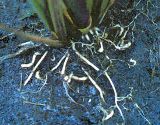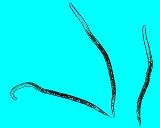|
Root Knot Nematode
| Symptoms |
|
| |
|
- Characteristic hooked-like galls on roots
- Newly emerged leaves appear distorted and crinkled along the margins
- Chlorosis and Stunting
- Heavily infected plants flower and mature early
- Reduction in number of tillers
- Size of the ear head is reduced with reduced number of grains
|
 |
| root knot nematode |
| Top |
| |
Identification of pest |
|
|
 |
Adult females appear to be pear-shaped to spheroid with elongated neck, which is usually embedded in root tissue. The stylet is mostly 9-18 µm long with tree small, prominent, dorsally curved basal knobs.
Infective second stage juveniles are short (0.3-0.5 mm) and have a weak cephalic framework. The tail tip tapers to a long, fine point with a long hyaline region.
|
| Root knot Nematode |
 |
| Root Knot Nematode |
| Top |
| Management Strategies |
|
- Cultural control includes continuous flooding, raising the rice seedlings in flooded soils, and crop rotation.
- Soil solarization with 50 – 100µ clear polythene sheets for 3 weeks before preparation of fields.
- Bare fallow period and planting cover crops such as sesame and cowpea has been reported to decrease nematodes.
- Rotation crop like marigold (Tagetes sp.) is also effective in lowering root knot nematode populations because of its nematicidal properties.
- Resistant varieties such as IR cultivars can be grown.
- Nematicides applied as soil drenches and seedling root dips or seed soaks to reduce nematode populations.
- Seeds can be treated with EPN and carbofuran.
- The roots can be dipped in systemic chemicals such as oxamyl or fensulfothion, phorate, carbofuran, and DBCP.
- Telone can be injected into the soil before the crop is planted.
|
 |
| Resistant variety- IR 32 |
 |
| Telone |
| Top |
|





